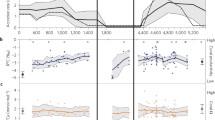Summary
A threshold for atoll formation, herein termed the Darwin Point, exists at the northern end of the Hawaiian Archipelago at 29°N latitude. Hawaiian atolls and coral islands transported northwest by tectonic movement of the Pacific Plate appear to have “drowned” near the Darwin Point during the last 20 million years. Measures of gross carbonate production by corals across the archipelago show that growth rates decrease with increasing latitude. At the Darwin Point, corals may contribute only 20% of the calcium carbonate necessary to keep pace with recent changes in sea level and thus appear to be more important as builders of framework than producers of limestone. Reduction in this function rather than total carbonate production may be the determining factor in the formation of atolls and coral islands. Elsewhere in the world other Darwin Points may exist but probably not at the same latitude due to differences in ecological conditions, coral species composition, island area, rates of erosion and tectonic histories.
Similar content being viewed by others
References
Adey W (1978) Coral reef morphogenesis: A multidimensional model. Science 202:831–837
Bloom A (1971) Glacial-eustatic and isostatic controls of sea level since the last glaciation. In: Turekian K (ed) The late cenozoic glacial ages. Yale University Press, New Haven pp 355–379
Buddemcier R, Maragos J, Knutson D (1974) Radiographic studies of reef exoskeletons. 1. Rates and patterns of coral growth. J Exp Mar Biol Ecol 14:179–200
Chappell J (1974a) Relationship between sea levels, 18O variations and orbital perturbations during the last 250,000 years. Nature 252:199–202
Chappell J (1974b) Late quaternary glacio- and hydro-isostacy on a layered earth. Quaternary Res 4:405–428
Chave K, Smith S, Roy K (1972) Carbonate production by coral reefs. Mar Geol 12:123–140
Dana T (1971) On the reef corals of the world's most northern atoll (Kure: Hawaiian Archipelago). Pac Sci 25:80–87
Darwin C (1942) Coral reefs. Smith Elder, London
Darwin C (1962) Coral islands—with introduction, map and remarks by D. Stoddart. Atoll Res Bull 88:1–20
Davies P, Kinsey D (1977) Holocene reef growth—One Tree Island, Great Barrier Reef. Mar Geol 24:1–11
Davies T, Wilde P, Clague D (1972) Koko Seamount: a major guyot at the southern end of the Emperor Seamounts. Mar Geol 13:311–321
Greene H, Dalrymple G, Clague D (1978) Evidence for northward movement of the Emperor Seamounts. Geology 6:70–74
Grigg R, Dollar S (1980) The status of reef studies in the Hawaiian Archipelago. In: Grigg R, Pfund R (eds) Proceedings of status of resource investigations in the Northwestern Hawaiian Islands. UNIHI Seagrant-Mr-80-04:100–119
Gross M, Milliman J, Tracey J, Ladd H (1969) Marine geology of Kure and Midway Atolls, Hawaii: A preliminary report. Pac Sci 23:17–25
Hoffmeister R, Multer M (1964) Growth-rate estimates of a Pleistocene coral reef off Florida. Geol Soc Am Bull 75:353–358
Jackson E, Koisumi I, Dalrymple G, Clague D, Kirkpatrick R, Greene H (1980) Introduction and summary of results from DSDP Leg 55, the Hawaiian-Emperor hot-spot experiment. In: Shambach J (ed) Initial reports of the deep sea drilling project 55. US Govt Printing Office, Washington DC, pp 5–31
Kinsey D (1979) Carbon turnover and accumulation by coral reefs. PhD Thesis, Univ Hawaii
Kinsey D, Davies J (1979) Carbon turnover, calcification and growth in coral reefs. In: Trudinger P, Swaine D (eds) Biogeochemical cycling of mineral forming elements. Elsevier Press, Amsterdam, pp 131–162
Knudsen D, Buddemeier R, Smith S (1972) Coral chronometers: seasonal growth bands in reef corals. Science 177:270–272
Ladd H, Tracey J, Gross M (1970) Deep drilling on Midway Atoll. US Geol Survey Prof Paper 680-A:1–22
Land L, Goreau T (1970) Submarine lithification of Jamaican reefs. J Sediment Petrol 40:457–462
Maragos J (1972) A study of the ecology of Hawaiian reef corals. PhD Thesis, Univ of Hawaii, 290 pp
McKenzie J, Bernoulli D, Schlanger S (1980) Shallow water carbonate sediments from the Emperor Seamounts: their diagenesis and paleogeographic significance. In: Shamback J, (ed) Initial reports of the deep sea drilling project 55. US Govt Printing Office, Washington DC, pp 415–456
Moore T, Burckle L, Geitzenauer K, Luz B, Molina-Cruz A, Robertson J, Sachs H, Sancetta C, Thiede J, Thompson P, Wenkam C (1980). The reconstruction of sea surface temperatures in the Pacific Ocean of 18,000 B.P. Mar Micropaleo 5:215–247
Morgan W (1972) Deep mantle convection plumes and plate motions. Am Assoc Petrol Geol Bull 56:203–213
Purdy E (1974) Reef configurations: cause and effect. In: Laporte L (ed) Reefs in time and space (Soc of Econ Paleon and Min Spec Pub 18:9–76, Tulsa, US)
Rotondo G (1980) A reconstruction of linear island chain positions in the Pacific: a case study using the Hawaiian Emperor chain. MS Thesis, Univ of Hawaii, 58 pp
Schlanger S (1963) Subsurface geology of Eniwetok Atoll. US Geol Surv Prof Paper 260-BB:991–1066
Schlanger S, Gillett G (1976) A geological perspective of the upland biota of Laysan Atoll (Hawaiian Islands). Biol Linn Soc 8:205–216
Smith S, Kinsey D (1976) Calcium carbonate production, coral reef growth and sea level change. Science 194:937–939
Thurber D, Broecker W, Blanchard R, Potratz H (1965) Uranium-series ages of Pacific atoll coral. Science 149:55–58
Tracey J, Ladd H (1977) Quaternary history of Enewetak and Bikini Atolls, Marshall Islands. In: Cameron A, Campbell B, Cribb A, Endean R, Jell J, Jones O, Mather P, Talbot F (eds) Proc 2nd Int Coral Reef Symp, vol 2, pp 537–550
Wilson J (1963) A possible origin of the Hawaiian Islands. Can J Phys 41:863–870
Author information
Authors and Affiliations
Additional information
Hawaii Institute of Marine Biology Contribution No. 627
Rights and permissions
About this article
Cite this article
Grigg, R.W. Darwin Point: A threshold for atoll formation. Coral Reefs 1, 29–34 (1982). https://doi.org/10.1007/BF00286537
Received:
Accepted:
Issue Date:
DOI: https://doi.org/10.1007/BF00286537




